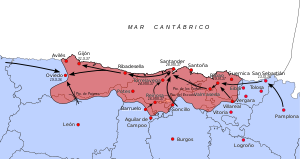
Back هجوم الشمال (الحرب الأهلية الإسبانية) Arabic Паўночнаіспанская кампанія Byelorussian Северна офанзива (Гражданска война в Испания) Bulgarian Krieg im Norden German Ofensiva del Norte Spanish Iparraldeko frontea (Espainiako Gerra Zibila) Basque Campagne du Nord French Kampene i Nord-Spania NB Campanha do Norte Portuguese
| War in the North | |||||||
|---|---|---|---|---|---|---|---|
| Part of the Spanish Civil War | |||||||
 Map of the campaign | |||||||
| |||||||
| Belligerents | |||||||
|
|
| ||||||
| Commanders and leaders | |||||||
|
|
| ||||||
| Strength | |||||||
|
120,000 soldiers thousands of anarchists milicianos[1] 250 artillery pieces 40 tanks 70 aircraft 2 destroyers 7 armed trawlers |
100,000 Nationalist soldiers 60,000 Italian soldiers[2] 400 artillery pieces 230 aircraft 1 battleship 2 cruisers 1 destroyer | ||||||
| Casualties and losses | |||||||
|
33,000 dead 100,000 prisoners one destroyer |
10,000 dead one battleship | ||||||
The War in the North (Spanish: Ofensiva del Norte) was a theatre of the Spanish Civil War that occurred in northern Spain from 31 March to 21 October 1937.
The Nationalists launched a number of offensives into parts of the Basque Country, Santander (Cantabria), and Asturias that formed an enclave loyal to the Republican government. The Biscay Campaign from March to July saw the bombing of Guernica and Durango and resulted in the Republicans losing the Basque Country after the Battle of Bilbao. The Nationalists captured Santander in September after the Battle of Santander and launched the Asturias Offensive against the last northern Republican stronghold in eastern Asturias. The Battle of El Mazucu saw fierce Republican resistance against Nationalist attacks and possibly the first use of carpet bombing against a military target. The War in the North ended when the Nationalists broke through the Republican lines and captured the city of Gijón at the end of October.